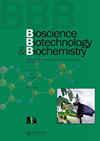表现出不同菌落颜色的 Aurantiochytrium 突变菌株改变了角鲨烯的含量。
IF 1.4
4区 生物学
Q4 BIOCHEMISTRY & MOLECULAR BIOLOGY
引用次数: 0
摘要
Aurantiochytrium sp. 18W-13a是一种属于thraustochytrid属的海洋异养原生生物,可积累大量角鲨烯和类胡萝卜素。目前,微生物的诱变育种仍被广泛采用,因为 DNA 的诱导突变不涉及异源 DNA 序列的永久整合。因此,在本研究中,我们重点利用 Aurantiochytrium sp. 18W-13a 通过诱变育种提高角鲨烯产量。由于类胡萝卜素和角鲨烯的合成途径有一个共同的中间体,因此我们建议使用菌落颜色作为筛选高角鲨烯积累突变体的首要标准,以避免大量的筛选工作。我们选择了碳离子照射后颜色较浅(白色)的突变体。白色突变体的角鲨烯产量是原始菌株的两倍。结果清楚地表明,目前的菌落颜色筛选方法有望获得高产的角鲨烯菌株。本文章由计算机程序翻译,如有差异,请以英文原文为准。
Aurantiochytrium mutant strains exhibiting different colony colors altered the contents of squalene.
Aurantiochytrium sp. 18W-13a, a marine heterotrophic protist belonging to the genus thraustochytrid, is known to accumulate high levels of squalene and carotenoids. Nowadays, the mutagenesis breeding of microorganisms is still widely practiced because the induced mutations of DNA do not involve the permanent integration of heterologous DNA sequences. Therefore, in this study, we focused on the improvement of squalene yield by mutagenesis breeding using Aurantiochytrium sp. 18W-13a. To bypass the massively laborious screening, we propose to use colony colors as the first criterion to screen mutants with high squalene accumulation, since the carotenoid and squalene synthetic pathways share an intermediate. We selected pale (white)-colored mutants after carbon ion irradiation. The white mutants exhibited larger squalene yields than twice as much of the original strain. The results clearly indicate that the present screening method with colony colors promises to obtain productive strains of squalene.
求助全文
通过发布文献求助,成功后即可免费获取论文全文。
去求助
来源期刊

Bioscience, Biotechnology, and Biochemistry
生物-生化与分子生物学
CiteScore
3.50
自引率
0.00%
发文量
183
审稿时长
1 months
期刊介绍:
Bioscience, Biotechnology, and Biochemistry publishes high-quality papers providing chemical and biological analyses of vital phenomena exhibited by animals, plants, and microorganisms, the chemical structures and functions of their products, and related matters. The Journal plays a major role in communicating to a global audience outstanding basic and applied research in all fields subsumed by the Japan Society for Bioscience, Biotechnology, and Agrochemistry (JSBBA).
 求助内容:
求助内容: 应助结果提醒方式:
应助结果提醒方式:


